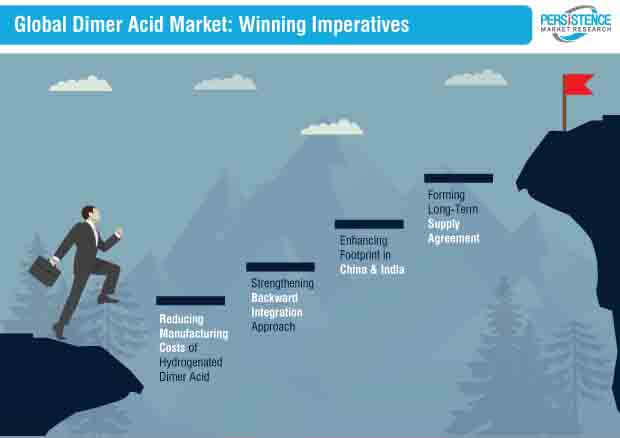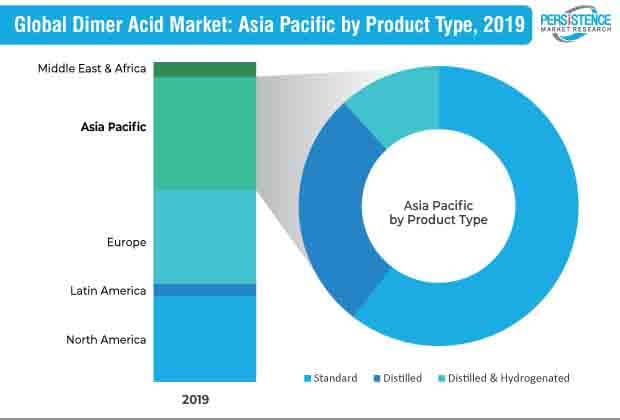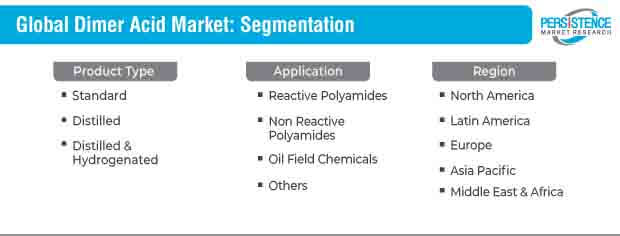Dimer Acid Market Segmented By Standard, Distilled, Distilled and Hydrogenated Product Type with Reactive Polyamides, Non Reactive Polyamides and Oil Field Chemicals Application
ID: PMRREP4371
Format: PPT*, PDF, EXCEL
Last Updated: 9 July 2019
Industry: Chemicals and Materials
Number of Pages: 190

The unrelenting quest for novel chemical compositions of automotive adhesives and sealants, paints and coatings that can withstand high state of pressure goes hand in hand with the evolution standing strong in the manufacturing and construction industries.
Growing unmet needs in industrial as well as consumer applications have spawned rigorous developments in these products, in line with the dire need for improving their bonding performance and functionality. Additionally, as the chemical industry aspires to progress towards a greener future, natural oleochemicals are increasingly infiltrating various industries for their wide applications.

Gauging the potential opportunistic value of this market, Persistence Market Research (PMR), in its latest business intelligence, evaluates how new dimer acid-based hot melt adhesives are opening door to greener joining materials for wide applications over traditionally-used adhesives. The study also turns the spotlight on incisive insights and comprehensive analysis of the dimer acid market, which can arm partakers with the vital facts and statistics of the industry, so as to make winning decisions.
The use of dimer acid as a raw material for end products with a plethora of applications tracks back to the time when sealants and adhesives started getting traction for bringing together different components in various end-use industries. However, the adoption picked pace when manufacturers realized the potential value of dimer acid for the production of non-VOC materials.
The PMR analysis points towards an upward trajectory for dimer acid since 2014, as the market gained pace by valuing ~US $238,538 Mn in 2014 to ~US$ 275,142 Mn in 2018.
As per the study estimates, dimer acid has growth in its cards in 2019, and beyond, as the market is envisaged to register a 1.4x growth between 2019 and 2029. Additionally, although the number of stakeholders vying for a significant pie of the market is currently low, it is highly likely to increase with each passing year.
As regulatory agencies, including the Environment Protection Agency (EPA), continue to enforce stringent rules to reduce VOC emissions from products used in industries and household products, manufacturers are being forced to adopt additives that fall comply with the regional regulations. While industries head towards adopting products that are based on acids obtained from renewable raw materials, dimer acid is rapidly emerging as a material of choice across application areas.
Stringent regulations surrounding the use of high-VOC levels additives in paint and coating products over the past few years have led to a significant surge in the adoption of bio-based variants, such as dimer acid. While companies focus on product reformulation to promote their product lines as low-VOC, the adoption of dimer-based additives has grown substantially.
The future holds high growth for dimer acid-based reactive polyamides in line with their escalating applications as epoxy curing agents in two-component epoxy systems for marine maintenance and industrial coatings, flooring grouts, trowel coatings, and epoxy-based adhesives.
Growing awareness among manufacturers about the plethora of advantages of hot melt adhesives over conventional water- and solvent-based adhesives, as they cut on VOC emissions and are cost effective is pacing up market growth. Furthermore, favorable government and environmental regulations have been driving the adoption of dimer acid at a steady rate.
Significant drift in focus of diverse end-use industries, such as construction on leveraging high-quality end-products with properties, such as higher resistance to oxidation and higher heat stability, continues to contribute to the lucrativeness of dimer acid market.
Significant traction for dimer acids in printing inks to provide relatively higher gloss and enhanced substrate adherence to the inks continues to add value to the attractive market potential. The crucial role of dimer acid-based polyamide resins in enhancing the overall quality of printing inks by exhibiting improved freeze thaw characteristics to the compositions continues to drive sales.

Banking on Backward Integration for Robust Supply Chain
The highly volatile nature of raw materials required for producing dimer acids has been slowing down the pace of growth of stakeholders in dimer acid market. Amid the growing struggles surrounding the highly volatile nature of raw material that further impacts the pricing of dimer acid, leading market players are banking on strengthening backward integration approach. This is further allowing companies to maintain their product supply and underpin gains by exploiting the positive customer sentiment and forming stronger and long lasting business bonds
. For instance, Kraton Corporation, a leading player in dimer acid market is backward integrated to a vital raw material Tall Oil Fatty Acid (TOFA) to enable the supply security for its dimer acids customers. Formation of long term supply agreement with end users is another significant strategy that holds high bets for growth in dimer market.
Leveraging Opportunistic Potential of China & India
Growth opportunities remain abound for dimer acid applications in the Asia Pacific region, primarily driven by the high demand for effective adhesives in proliferating end-user industries in China and India. Asia Pacific dimer acid witnessed sales worth US$ 188.6 Mn in 2018, and is likely to account for ~35% share in the overall dimer acid market value.
With an estimated chemical sales worth US$ 3,926.4 Bn in 2018, China remains a top manufacturing hub of specialty chemicals globally. Additionally, in light of the rising demand for construction materials, such as adhesives & sealants and paints & coatings, among other products, demand for dimer acid as a constituent has grown substantially in recent years.
An upsurge in oilfield drilling and construction activities is also complementing the applications and adoption of dimer acid in the region, thereby, making it a lucrative well of opportunities for market players. Tough, dimer acid is rapidly gaining a center stage for a wide pool of applications, the high pricing of distilled & hydrogenated dimer acids tend to limit the sales.
However, the regained focus of several market players on squeezing profit margins by reducing manufacturing cost of in-demand, high purity distilled & hydrogenated dimer acid is likely to surface and draw higher gains in the market.
The dimer acid market can be characterized by the presence of numbered companies that are vying rigorously to gain a stronger position in the industry. Intensity of competition in dimer acid market is relatively moderate to high, with Kraton Corporation leading the market in terms of supply of dimer acid across the globe and is followed by companies, such as Croda Inc., and Emery Oleochemicals Group.
Considering the supply-demand dynamics, the balance is slightly tilted in favor of sellers – a consortium of leading players collectively dictates the end-price at which dimer acid is made available to end-use industries.
In the business journey, the big shots in dimer acid market are working on building robust customer relationship, which helps them direct their R&D efforts in catering to their niche demands. Additionally, their focus of interest lies in strengthening product portfolio of TOFA derivative chemicals, as Kraton Corporation expanded its offerings with the acquisition of the Arizona Chemical. The product distribution expansion is also garnering traction as an instrumental way to underpin gains in the dimer acid market.
For instance, in January 2019, Emery Oleochemicals expanded its distributor partnership with Omya Inc., which is expected to provide technical support to its U.S. based customers for Emeyr’s Green Polymer additive products.

The author(s) of the report maintains an optimistic outlook of the dimer acid market, which is envisaged to register a CAGR of ~4.8% during the time frame of 2019-2029. Companies focusing on accommodating the upswings in raw material costs by leveraging powerful approaches, such as backward integration and in-house manufacturing are likely to gain a stronger position in the market through 2029.
Dimer acids belong to the class of dicarboxylic acids, which are synthesized through the catalysis of unsaturated fatty acids. Generally, fatty acids are used in the synthesis of dimer acid obtained from tallow or veg base sources such as soybean oil, tall oil, rapeseed oil, to name a few. In the chemical industry, dimer acids are prevalently used as chemical intermediates for the synthesis of non-reactive and reactive polyamide compounds.
Generally, dimer acid-based reactive polyamides are used as curing agents for epoxy resin. Along with this, dimer acid has applications in flexographic printing inks, adhesives & sealants, and curing of epoxy resins, among others.
This global report offers our perspective on how the growth of the dimer acid market will unfold. The global dimer acid market is projected to grow with a CAGR of ~4.0% by value during the forecast period and in terms of the value, it is anticipated to grow from ~US$ 600 Mn in 2019 to ~US$ 830 Mn in 2029. In terms of the global demand for dimer acid, the market was pegged at ~275 Kilo Tons in 2018, which is estimated to indicate a CAGR of ~4% to reach ~399,599 MT by the end of 2029.
Healthy rise in the demand for dimer acids from prominent end-user industries such as inks & coatings, and adhesives, among others, is estimated to provide impetus for the market growth during the period of 2019-29.
Spending in construction activities in North America is projected to showcase a stable growth during the forecast period. This is likely to witness a high demand for adhesives and coatings among others, which in turn, is estimated to portray a healthy growth of the dimer acid market over the forecast period.
Moreover, with significant rise in the oil & gas production in North America, particularly in the U.S. The demand for dimer acid-based oil field chemicals is projected to increase substantially during the latter half of the forecast period.
The Asia Pacific dimer acid market is estimated to represent a strong CAGR due to the increasing development activities, infrastructure, and growth in transportation, automotive, energy, electronics, and other industries in countries such as China and India. China is the major user of hot-melt adhesive products, owing to the increasing demand from the manufacturing sector.
The hot-melt adhesives market in APAC is expected to grow significantly over the forecast period and represent high growth opportunities for dimer acid industry players. The APAC dimer acid market indicates almost one fourth of the global consumption of hot-melt adhesives in 2018, and is expected to account for a share of ~35% by 2029.
For the production of biofuels, generally used feedstock are tall oil and vegetable oils, which are also used as raw materials for dimer acids. Therefore, the growing demand for biofuels is anticipated to affect the availability of raw materials for the production of dimer acid. The lack of government regulations on the use of solvent-based adhesives is subsequently affecting the growth of the hot-melt adhesive market.
Several prominent industry players in developed regions are opting for hot-melt adhesives, but there remains a strong demand for conventional solvent-based adhesives in the market. Due to these factors, the growth of the dimer acid market is expected to slow down during the forecast period.
The uplift in the Asia Pacific dimer acid market is backed by the rising demand for standard dimer acids, which are of relatively low-price. However, in the past few years, several industry participants have started opting for more high quality products such as hydrogenated and distilled dimer acids. Although, these dimer acid products are comparatively expensive, they possess several beneficial properties such as resistance to heat and oxidation.
PMR’s study analyses the dimer acid market based on product type, application and region. The report presents exhaustive insights of dynamics and rapidly altering trends associated with each segment, and how they are shaping the growth of dimer acid market.
| Attribute | Details |
|---|---|
| Product Type |
|
| Application |
|
| Key Regions |
|
For more information on this report and its delivery timelines please get in touch with our sales team.